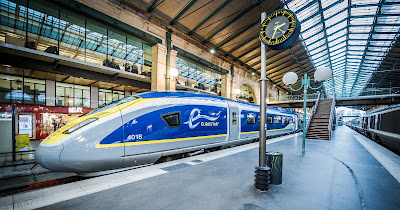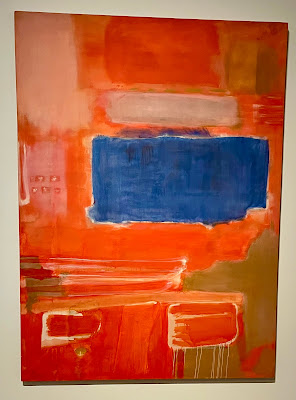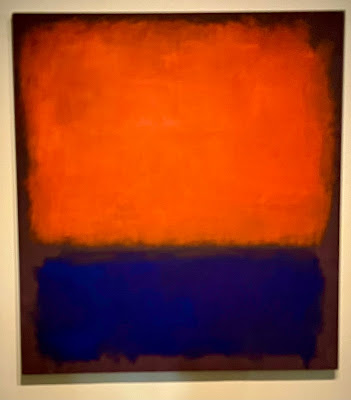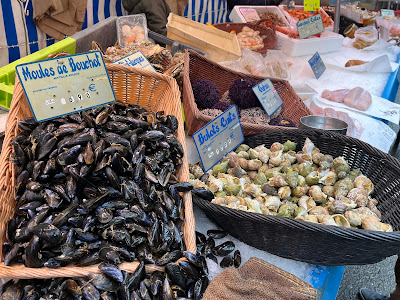Every time we are here, we marvel at the French transportation system. The Paris metro zips you across town in a matter of minutes. The buses take a little longer, but provide a tip-top view of Parisian icons along the way. And then there are the trains, both local RER and long distance TGV (high speed trains or trains de grands vitesse). And where you have trains, you have train stations, superb monuments to the history of travel from earliest steam to latest electric. Also a tribute to the 19th century industrial revolution, with their cast iron construction, and clear glass skylights spilling light onto the platforms.
 |
| "Arrival of a Train, Gare St. Lazare" (Claude Monet, 1877) |
In the 1870s, Monet, along with his fellow impressionist painters, took trains from the Gare St. Lazare to Argenteuil, where they created beautiful works en plein air. Others went further into Normandy to Etretat. Today, travellers use the station to commute from local towns, or to go much further to escape the noise and bustle of the city.
 |
| (photo from USA Today) |
At the Gare du Nord, travellers are offered trains heading north (as the name suggests), as well the opportunity to step aboard the Eurostar, and in 2-1/2 hours find themselves in central London!
 |
| Gare de l'Est (photo from Paris Moments) |
Built right next door to the Gare du Nord, the Gare de l'Est connects
you to the north and the east, to Reims (champagne country), Strasbourg,
Luxembourg.
In the left wing of the building hangs one of my favorite, and most moving, public works of art, titled "Le Départ des Poilus", ("The Departure of the Doughboys"), by the American artist, Albert Herter. Herter's son, Everit, is depicted in the center of the mural, his arms outstretched, a bouquet of flowers stuffed down the head of his rifle. On the left, a white-haired woman (Herter's wife) stands, grieving. Everit Herter had enlisted in 1917, and died in 1918 fighting with the American Expeditionary Force in Eastern France. This mural was Herter's way of paying tribute to his son and all the other sons lost in that Great War. He completed the work in 1926 and donated it to the people of France. It was installed that same year at the Gare de l'Est, departure point for troops in WWI.
On the other side of town, in the 12th arrondissement, stands the regal Gare de Lyon, with its imposing clock tower, reminiscent of Big Ben in London. Like the other railway stations, the original building went up in the 1850's, but this one was considerably rebuilt in the 1870s following a fire during the Paris Commune.
Its destinations are to the South, to Nice, Marseilles, Antibes, Cannes, as well as the French Alps and into Switzerland, to Lausanne and Zurich. You can even take a train from Paris to Barcelona from this station!
Every station, near and far, has its indoor clock, this one is almost overshadowed by the beautiful wrought-iron roof with its sparkling skylights.
We were not traveling south on this particular day, though. We were here to have luncheon at the super-elegant, historic Le Train Bleu restaurant, standing proudly, front and centre, in the heart of the Gare de Lyon. In bygone days, there was a train service created by the Compagnie Internationale des Wagons-Lits, modeled on their successful Orient Express. Originally called the Calais-Paris-Rome Express, it later ran from the Gare de Lyon to the Côte d'Azur, and took the name Le Train Bleu. With its luxurious dark blue carriages and elegant couchettes and five course dinners served in the dining car, it soon became the darling of British aristocrats and wealthy Parisians. However, the arrival of airplane travel and, later, the high-speed trains spelled its doom. The name lives on, though, in this gorgeous restaurant.
The "Buffet de la Gare de Lyon", as it was originally named, was created to honor the Universal Exhibition of 1900, part of a major city-wide planning initiative that included the Petit Palais and the Alexander III Bridge. Built by the railway company, PLM (Paris-Lyon-Méditarranée), it was inaugurated by the French President, Emile Loubet in 1901. When the actual Blue Train stopped service in the 1960's, the name was transferred to the restaurant. The photo above is the sight that greets you when you walk in. Our jaws immediately began to drop!
Here's a closer look at the one on the right showing visitors attending a performance at the Roman amphitheatre in the city of Orange, in the Vaucluse department of Provence.
At the other end of the main restaurant are two more murals, these by Frederic Montanard, depicting Villefranche on the left, and Monaco on the right.
And if you looked up, there were more and more wonders to gasp at and admire. In fact, our jaws were dropping so often that we almost forgot why we were here: to have lunch and make sure a young family member got on the right train to Dijon later in the afternoon!
It was time to get down to business and make our picks from many delicious offerings...
 ..some in the party chose rack of lamb, which was brought to the table in a sizzling pan, and carefully divided...
..some in the party chose rack of lamb, which was brought to the table in a sizzling pan, and carefully divided......before being placed before a very hungry Matthew!
Others of us chose the leg of lamb, carved at the table by the head waiter himself...
...still others went the healthy route with delicious ravioli!
However, they more than made up for that with this fabulous Vacherin dessert, layers of French meringue, topped with sorbet and fresh fruits, surrounded with balls of ice cream!Matthew settled for the Café Gourmand...
...but the pièce de resistance was this flaming crèpe suzette, stirred and swirled and then brandied and flambéed at the table by this very serious gentleman, who served it without ever cracking a smile!
During our meal, an extraordinary thing happened: this uniformed gentleman, who had led us to our table in the classic formal manner when we arrived, suddenly walked through the restaurant, ringing a bell non-stop to gain everyone's attention. He then threw himself into delivering a monologue from Jean Racine's "Andromache", in Alexandrine verse, striding up and down the centre aisle, gesticulating, emoting at full voice. This famous tragedy was first performed in front of Louis XIV at the Louvre in 1667, and I studied it in French in my English High School in 1955! When our restaurant thespian reached the end of his performance, he received a standing ovation. Is he a frustrated actor, who works as assistant to the Maître'D at Le Train Bleu to pay his bills, but whose ambitions reach far beyond?
We lingered over our coffees, absorbing these beautiful early 20th century surroundings before we headed out and back into the 21st century. At the entrance, we stopped and checked out the items in a display case filled with nostalgia. Ivory fans, opera glasses, glassware, all from an earlier era, when life moved at a more leisurely pace.
Outside, the early Saturday evening crowd was bustling to and from platforms, the station announcer making sure everyone knew when their train was leaving or arriving, with the distinctive "ding-dong-ding" sound alerting a new pronouncement. Happily, our family member made their train with time to spare.
I walked over to the rue Daumesnil to catch the #29 bus that would take me on a wonderful, roundabout tour of the Marais, before dropping me at the bottom of the rue Montorgeuil, a short stroll from home. How easy it is to get around this city, and this country! Hooray for French trains, buses and metros!
 | ||||||||||||||||
|









































